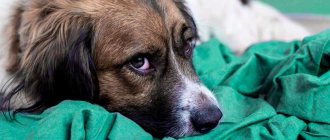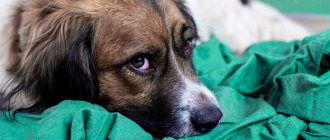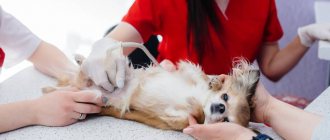Gastroenteritis in dogs is a disease of the gastrointestinal tract of predominantly infectious etiology, accompanied by the progression of inflammatory foci, spasmodic pain and indigestion against the background of severe intoxication of the whole body.
The disease is an inflammatory process of the mucous membrane of the stomach and intestines. Most often it occurs spontaneously and occurs in an acute form. In advanced stages of gastroenteritis in a dog, the inner layer of the stomach and intestinal muscles is deformed, which leads to a malfunction of the digestive system and dysfunction of secretion.
How and why dogs get gastroenteritis
The most common cause of the disease is viral or bacterial infection. The main risk group for contracting gastroenteritis includes puppies, elderly and adult compact (small) breeds.
Infection with microbes occurs due to ingestion of low-quality or dirty food, overeating or vitamin deficiency. For example, a dog will eat rotten food while walking, which will provoke acute poisoning and initiate the process of inflammation of the gastrointestinal mucosa. With systematic vitamin deficiency, the dog does not receive enough vitamin supplements in the food necessary for growth and development, which disrupts metabolic processes in the body and reduces immune defense. A weak pet is most often susceptible to infection from the outside and is not able to resist diseases without appropriate treatment. Oversaturation of food in a pet’s diet leads to digestive dysfunction, which affects intestinal patency and motility. Stagnant masses are often sources of bacterial development and, as a consequence, the appearance of an inflammatory process.
The source of viral infection in a healthy dog can be a dog with gastroenteritis. The carrier of gastroenteritis is active from the moment of infection and excretes the pathogen through vomit and feces throughout the entire period of the disease.
The secondary form of development of symptoms of gastroenteritis in a pet is considered to be repeated endoparasitic invasions, pathologies of viral origin, chemical poisoning or volvulus.
It is especially dangerous for a dog to become infected with a coronavirus or parvovirus infection. If left untreated, the pet may die within 2–3 days after infection.
An advanced form of gastroenteritis is the cause of the development of intestinal plague, and a high probability of death cannot be ruled out.
Veterinarians say the main reason for a pet’s death from infection is a late visit to the doctor.
Veterinary research has proven in practice that more than 95% of adult dogs have been cured of viral gastroenteritis. The survival rate among one-year-old puppies is lower. This depends on the resilience of the dog’s young body and the degree of advanced disease at the time of treatment.
Remember, the speed of contacting a veterinarian after detecting the first signs of illness depends on the life of your pet.
Is the disease dangerous for people?
Infectious gastroenteritis is transmitted to humans through casual contact.
Gastroenteritis of infectious origin poses a danger to humans. Viruses, bacteria and parasites are transmitted through household contact.
When treating a sick dog, a person must observe all necessary safety measures:
- wash your hands thoroughly after contact with animals;
- Don't let your dog into your sleeping area;
- on the recommendation of a veterinarian, disinfest the premises and thoroughly ventilate.
You should consult your veterinarian about specific preventive measures for each disease.
Types of gastroenteritis
According to viral etiology and degree of localization of pathology, gastroenteritis is divided into types:
- Membranous mucous.
- Diphtheric.
- Purulent.
- Croupous.
- Hemorrhagic.
- Phlegmonous.
- Mixed type.
Based on the analysis of the history of occurrence and the method of progression, gastroenteritis is classified as primary or secondary, chronic or acute.
If a parvovirus or coronavirus infection is suspected, the dog is subject to PCR tests.
Parvovirus gastroenteritis
A dangerous disease that has a massive spread similar to an epidemic. The causative agent is a virus, has low sensitivity to external influences, and dies only under the influence of boiling temperature.
In mild forms of the disease, the dog experiences severe apathy, loose stools and lack of appetite; with timely treatment, the condition stabilizes by the 5th day of the disease. In severe forms of parvovirus gastroenteritis, the animal is characterized by such symptoms as diarrhea up to 6–8 times a day, complete refusal of food, vomiting up to 5 times a day (in the vomit there is gastric mucus and remnants of undigested food), spasmodic pain in the abdomen, salivation and fever up to 40 degrees. With treatment, the dog’s condition returns to normal within a week.
Coronavirus gastroenteritis
A highly contagious pathology, it causes rapid dehydration, general intoxication and exhaustion against the background of rapidly developing inflammation of the gastrointestinal tract. In the absence of timely treatment, there is a high probability of death (after 2–3 days from the onset of symptoms). One-year-old puppies and adult animals with weak immune systems are at risk. A characteristic sign of the open form of coronavirus gastroenteritis is vomiting and stool with blood and mucus.
In the latent form of viral gastroenteritis, there are symptoms of weakness, lack of appetite, lethargy and low-grade fever.
Coronavirus gastroenteritis is especially dangerous for two-month-old puppies. The animals have virtually no chance of survival; death occurs within 48 hours.
Diagnostic methods
Although the diagnosis of gastroenteritis itself usually does not present any difficulties, additional research is required to establish its cause, since similar symptoms occur with pancreatitis, cholecystitis, hepatitis and other diseases of the digestive system, as well as with kidney pathologies. In addition, it is extremely important to find out the cause of the disease in order to cure it. Therefore, sick animals are given:
- general blood analysis;
- blood chemistry;
- Ultrasound examination of the abdominal organs.
In some cases, the doctor will immediately order an X-ray examination of the abdominal cavity. This is necessary if a foreign body is suspected (then they may recommend not only a regular x-ray, but also a series of images with the introduction of a contrast agent - barium), and also if an x-ray is available, but ultrasound diagnostics cannot be performed immediately.
X-ray and ultrasound do not replace, but complement each other: Ultrasound can evaluate peristalsis, but in most cases a foreign body cannot be suspected, but using both methods it is possible to assess the thickness of the walls of the gastrointestinal tract and the presence of inflammation in specific sections.
Basic studies will allow you to adjust therapy, but do not always provide a complete picture of what is happening to the animal. Additional research will help find out:
- virological studies - PCR or ELISA for coronavirus and parvovirus;
- clinical stool analysis;
- stool analysis for parasites – helminths and protozoa;
- gastroscopy.
The doctor must justify the need for each of these studies and clearly understand what exactly he wants to achieve with the help of its results.
How to detect in a dog
According to veterinarians, each dog reacts differently to the disease. Depending on the etiology of occurrence, age and physical health of the dog, the symptoms of the disease may develop non-standardly.
Common signs of gastroenteritis in a pet include:
- Weakness and refusal to eat. An initial sign of animal behavior that should alert you.
- Vomiting and diarrhea. Constant gag and fecal reflexes exhaust your pet. Diarrhea is often accompanied by increased gas formation and spasmodic acute pain in the intestinal area. An admixture of blood and mucus in the stool means a pathological localization of the source of infection in the rectum, which is typical for coronavirus gastroenteritis. Watery brown stools indicate localization of the inflammatory process in the small intestine.
- Drinks a lot. When the pathogen multiplies intensively, the body becomes severely dehydrated, and the dog requires water to replenish the water-alkaline balance.
- Pain syndrome. When trying to palpate the abdomen, the dog becomes nervous and aggressive. The abdominal wall is tense to the touch, spasms inside are accompanied by gurgling sounds.
- Temperature increase. On the first day of infection, a stable low-grade fever remains. A symptom of the dog's weakness and refusal to eat should alert you. Subsequently, there is a possibility of a rapid increase or decrease in temperature. These fluctuations are very dangerous symptoms; the pet urgently needs urgent medical attention.
- Sudden weight loss. Against the background of the asymptomatic onset of the disease, the dog refuses to eat and becomes passive. If other signs are less pronounced, but the dog is rapidly losing weight, you should immediately consult a veterinarian.
Symptoms
Gastroenteritis in dogs has the following symptoms, which vary depending on the cause of the disease:
- Vomiting, which leads to a sharp deterioration in the pet’s condition, during which prompt therapeutic action is required.
- Diarrhea accompanied by abdominal pain caused by gas and muscle spasms. The stool may be unformed, watery or liquid.
- The pain in the abdomen is so severe that the pet does not allow the belly to be touched; he may be prone to aggression when attempting contact. You can hear gurgling and seething.
- Loss of appetite. It can be either full or partial.
- The overall activity of the animal decreases.
- The pet is losing weight. This happens because the dog does not eat well, and the food eaten is not completely digested or is partially digested.
- Gastroenteritis in a dog can be accompanied by either high body temperature, low body temperature, or even normal body temperature. When the symptoms are caused by inflammation of the intestines, then she may have a fever; if the culprits of the condition are helminths, then in weakened animals the temperature drops, in strong ones it remains at normal levels.
- Dehydration caused by diarrhea or vomiting. Moreover, there is a loss of not only water, but also minerals. If this condition is not noticed in time and treatment is not started, the pet may die.
Causes of gastroenteritis in dogs
The reasons that provoke the appearance and development of gastroenteritis include:
- toxic poisoning of a dog. When chemicals enter the stomach, the mucous membrane burns. Under the influence of an acidic environment, the affected areas become inflamed, causing dysfunction of the entire gastrointestinal tract;
- helminthic infestations. During the life of helminths, harmful amino acids are released that can injure the intestinal mucosa;
- gastroenteritis of a traumatic nature. Occurs against the background of internal injuries caused by swallowing objects and bones. In the absence of effective treatment, the pathology is complicated by intestinal obstruction.
- chronic intoxication of the body. Occurs against the background of oncological processes, liver diseases, kidney diseases, and other advanced pathologies;
- drug-induced gastroenteritis. Appears due to long-term use of antibiotics, cytostatics or other anti-inflammatory drugs.
Etiology and pathogenesis of the disease
The disease is a pathological condition manifested through inflammation of the intestinal and gastric mucosa. When the inflammatory process moves to the large intestine, gastroenterocolitis is diagnosed. In the advanced stage, the muscle layer is deformed, which is fraught with disruptions in the functioning of the digestive system and the appearance of secretory dysfunction.
Gastroenteritis - inflammation of the mucous membrane of the stomach and small intestine
Penetrating into the mucous membranes, protein exudate promotes the rapid growth of harmful microorganisms. Intoxication of the body, resulting from exposure to bacterial waste products, provokes deterioration in the functioning of the heart, kidneys and liver.
Chihuahuas , Pinschers, Toy Terriers are most susceptible to pathology . Young individuals are at risk. In older animals, the disease is less common.
Toy Terriers are more likely to suffer from gastroenteritis than other breeds.
Causes
In addition to natural and age-related predisposition, the disease develops as a result of various following factors.
Table. Causes of gastroenteritis
| Causes | Description |
| Low quality food | Errors in the nutrition system, food picked up from the ground, regular excess of feeding standards and lack of nutrients contribute to the formation of fermentation reactions in the organs of the digestive system. As a result, the mucous membranes are damaged, then gastroenteritis develops |
| Infections of viral etiology | Exposure to infectious agents leads to the development of parvovirus and coronavirus varieties of the disease |
| Poisoning | Food and chemical poisoning contribute to the occurrence of inflammatory processes in the gastrointestinal tract |
| Worm infestations | Parasites negatively affect the mucous membranes. This is caused both by the physical impact of helminths on the membranes and by toxic substances formed during their life activity |
| Chronic intoxication | It is typical for pathologies of the liver and kidneys, as well as for the development of cancer. One of the consequences of these diseases is the manifestation of symptoms of gastroenteritis |
| Use of medications | After a course of non-steroidal anti-inflammatory drugs or cytostatics, deformations of the gastric mucosa may occur |
When the intestines are twisted, a secondary form of pathology is formed.
The presence of helminths is one of the causes of the disease
Diagnosis of gastroenteritis in dogs
Diagnosis of this disease in dogs is carried out through a comprehensive examination. First, the animal’s life history is clarified, the veterinarian collects data on the pet’s diet, vaccination, living conditions and walking conditions.
The diagnosis is made based on:
- clinical examination - palpation of the gastrointestinal tract, thermometry and auscultation;
- data from laboratory analysis of biochemistry and TCA of blood, stool studies;
- survey ultrasound of the abdominal cavity, gastroscopy and, if necessary, radiography.
Laboratory tests assess the degree of damage to intestinal functionality, the stage of development of inflammatory processes, and determine the type of pathogen. Ultrasound data makes it possible to assess the level of damage, the localization of foci of gastrointestinal infection, and also identify the expected complication in the form of intestinal obstruction or adhesions. Visual diagnostic methods are used to clarify the diagnosis.
Good to know
- Why do cats hide pain?
- Serval cats
- Cat urine retention
- Causes of pain syndrome in cats
- Feline Orofacial Pain Syndrome
- Catnip for cats
- How to care for an old cat?
- How to properly dry a cat?
- How to Choose a Kitten for your Home
- Pneumonia of Cats
- Causes of Sneezing in Cats
- Anatomy and physiology of the liver in cats (general information, structure, vascularization, innervation)
- The structure and functions of the thyroid gland in cats (anatomy and physiology)
- Measuring blood pressure in cats before performing procedures under general anesthesia
- Current role of dexmedetomidine in clinical veterinary and medical anesthesia and intensive care
- Dynamic testing of thyroid function in cats
- Gabapentin in cats and dogs (all pros and cons, indications, contraindications, doses, features of use, instructions for use)
- Information content of hematological and echocardiographic preoperative screening indicators
- Historical background on hyperthyroidism in cats
- Hyperthyroidism in old cats (etiology, diagnosis and treatment)
- Cardiac hypertrophy in cats
- Analysis of anamnestic data during preoperative examination of small domestic animals
- Study of anamnestic data in cats that require manipulation under general anesthesia
- Method for measuring blood pressure in cats
- ICD in cats (diagnosis and symptoms)
- Hyperthyroidism is suspected, but serum T4 concentration is normal
- Acute gastroenterocolitis in dogs (etiology, pathogenesis, diagnosis and treatment)
- Reducing mortality during anesthesia is an important task of veterinary anesthesiology
- Thrombosis in cats (general information, etiology, pathogenesis, clinical picture, diagnosis and treatment)
- Urolithiasis of small animals (etiology, pathogenesis, diagnosis and treatment)
- Congestive cardiomyopathy in cats (What is it? How to protect your pets)
- Gastrointestinal tract in dogs (anatomy and physiology)
Treatment of gastroenteritis
The method of treating a disease in a dog includes complex medicinal methods aimed at stopping the root causes of the disease and eliminating systemic disorders of the digestive process.
If a viral genesis is detected in the dog, antiviral and immunostimulating therapy is carried out. Chemical gastroenteritis is treated by flushing the gastrointestinal tract, using antidotes and symptomatic drug support for the body. Infection with helminths is controlled by antiprotozoal and anthelmintic drugs.
If the cause of gastroenteritis was a foreign body entering the intestine, the veterinarian decides on surgical intervention or rectal removal of the object.
Gastroenteritis against the background of chronic pathologies is treated conservatively with the help of antiemetics, strengthening drugs and eliminating dehydration. At the same time, antibiotics are prescribed to relieve inflammation and immunomodulatory agents to support the immune system.
Simultaneously with drug therapy, systematic immunomodulatory treatment is carried out with auxiliary means of mechanical cleansing of the body - enemas based on herbal decoctions (chamomile, St. John's wort, calendula). The procedure quickly clears the intestines of fragments of liquid feces, soothes muscle tone, restores intestinal motility and reduces pain.
Drug therapy
Drug therapy involves the use of a wide range of drugs. Conservative treatment is prescribed by a veterinarian depending on the typology of the pathogen and the degree of development of gastroenteritis.
- Antimicrobial drugs. The drugs of the tetracycline or penicillin series are mainly used - Biseptol, Levomycetin, Furacilin, Fthalazol.
- Adsorbents.
- Painkillers.
- Enveloping drugs.
- Enzyme-containing medications.
- Antihistamines.
You should know that the decision to prescribe a specific drug is made only by a veterinarian, based on clinical and laboratory data on the pet’s condition.
It is not recommended to treat your dog yourself - many medications have side effects and can harm the animal.
If there is a clinical picture of severe dehydration, the pet is injected with Ringer's solution. The symptom of loss of appetite is relieved with meat broth or rice water, as well as vitamin and electrolyte infusions.
To maintain the water-alkaline balance of your pet, before the veterinarian arrives, you can make a special remedy at home. For 1 liter of boiled water, take 1.5 grams of calcium chloride, 2.5 grams of soda, 3.5 grams of salt and 20 grams of sugar. You can give the animal a solution of no more than 40 grams of solution per 1 kg of live weight until the liquid feces disappear completely.
Diet therapy
During the treatment period, the dog needs a well-balanced and high-quality diet. Therefore, during symptomatic therapy, the dog is prescribed a gastroenterological industrial diet.
How to plan a diet for a sick pet
To ensure the effectiveness of treatment, along with drug therapy, the pet is given a special diet.
- In the first days of treatment, to support the body and eliminate dehydration, the dog is given infusion therapy and given only water to drink.
- On the 2nd day, the introduction of herbal decoctions of flax, chamomile, chaga and meat broths is allowed.
- Boiled chicken eggs are added to the diet for 3–4 days of treatment, at the rate of 3 eggs per day for an adult dog.
- Subsequently, the dog is given rice or oatmeal porridge with meat broth, fermented milk products, and lean minced meat.
- After a week, boiled vegetables are introduced into the animal’s diet.
- If the outcome of conservative therapy is favorable, after a week and 10 days the dog is transferred to its usual diet.
- After treatment, for the first month it is recommended to refrain from feeding the dog peas, beans, bones and raw vegetables.
It is important to know that during the first months after recovery, when walking with your pet, stop his attempts to gnaw on foreign objects or chew grass. The precaution is necessary to prevent re-infection while the body's immune system is recovering.
Disease prevention
Preventative measures for canine gastroenteritis include:
- Regular external and internal antiparasitic treatment of the dog.
- Stable vaccination schedule for puppies and adults.
- Feed quality control.
- Disinfecting dog toys.
- Balanced diet.
If you have the slightest suspicion of illness, contact your veterinarian immediately. Do not self-medicate and do not waste time waiting for it to “go away on its own.”
How to help at home
If several of the above symptoms are present, only a veterinarian who has previously examined the dog will help get rid of the root cause of their appearance. Before this, the owner can only relieve the symptoms: for example, give an antipyretic injection with no-shpa or give the animal “Smecta” for an upset stomach. More radical treatment, with self-prescription of one or another drug, is excluded, since there is a possibility of worsening the pet’s poor condition.
Important! If before visiting the veterinary clinic, the dog was given any medications, you must inform the veterinarian about this. This will help you choose a further treatment regimen without conflicting medications.
Until the diagnosis is known, you should not overfeed your dog, especially solid food. In case of severe vomiting or diarrhea, a starvation diet is recommended for 24 hours, but clean water should always be freely available to the pet. If the house is constantly noisy, look for a secluded place for your four-legged friend, where no one will disturb your pet while resting. Although such measures will not help get rid of gastroenteritis, they will weaken the symptoms of its manifestation before a visit to the veterinarian, which in any case will be a prerequisite for preserving the health, and possibly the life of the pet.











